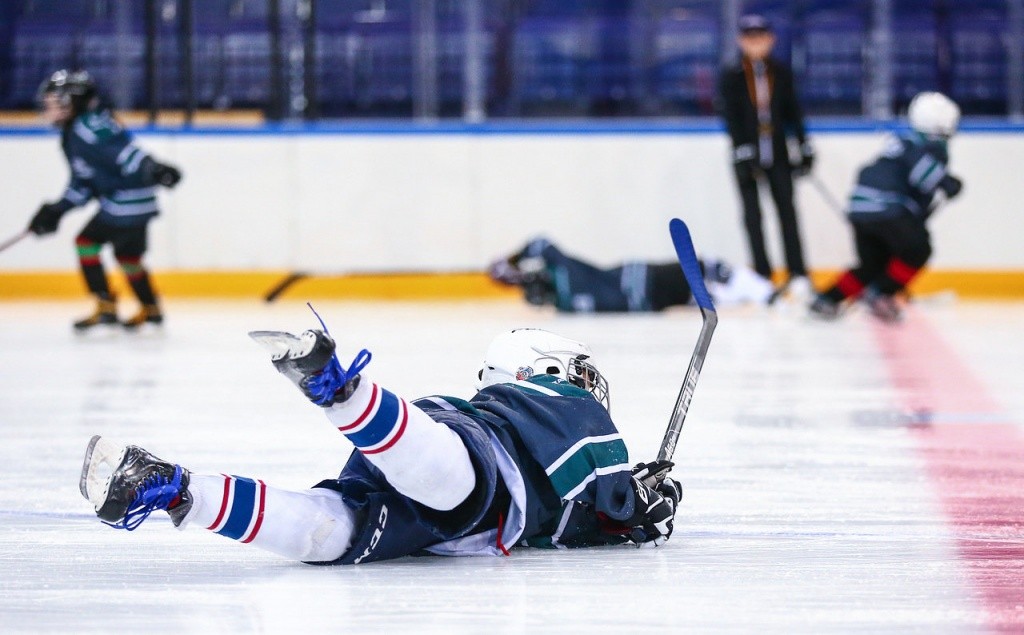Injury Prevention

Ice hockey is a really traumatic sport. Most often, hockey players of any age get bruises, sprain, dissection, muscle strain, fractures and concussions. Specific risk factors for injury are:
-
high speed. A hockey player can skate with velocity up to 48 km/h. In the event of a fall, the player’s movement is uncontrollable, and if the head moves forward, there is a great risk of injury to the cervical spine when it strikes the board or gate;
-
weight and dimensions of the puck. The thickness of the puck is 2.54 cm, the diameter is 7.62 cm, and the weight is 170 g. In combination with a speed of more than 80 km/h, the puck launched by the player is also regarded as a risk factor for injury. Most often, injuries occur when the puck hits the face and neck. In this regard, young hockey players should wear a helmet with mask that protects the entire face;
-
power struggle during the match and training. Boarding, body and limb strikes and other collisions lead to fractures of ribs, clavicles, pelvic bones, injuries to internal organs, brain damage;
-
sharp objects in hockey equipment. Cuts in open and unprotected parts of the players, strikes with a stick can lead to heavy bleeding. There are frequent cases of injury with a skate in the locker rooms when a player passing in skates accidentally steps on the bare leg of a teammate.
Injury in hockey is inevitable, but adherence to a number of rules will help to significantly reduce the risk of injury.
Rule 1. The coach should organize the training process in compliance with the provisions developed by the Center of Medical Support and the Research and Methodology Centre of the Academy.
Rule 2. The coach must constantly improve the level of physical and technical-tactical training of players.
Rule 3. In no case should the coach neglect the introductory part of the lesson, i.e. warm up. Good warming up of muscles and joints during the warm-up process reduces the risk of sprains and dislocations. Warming up also activates attention, improves coordination, which undoubtedly helps to avoid accidental injuries.
Rule 4. Carefully choose the kit for the child. With particular attention to choose and fit the skates.
Rule 5. Observe order and discipline at the field.
International standard of first aid for sports injury "RICE" - rest, ice, compression, elevation.[U1]
-
Rest. After getting injured, the player should immediately stop training and ensure maximum rest to the injured area. For slight bruises and sprains, the joint is immobilized with a fixing bandage. For strong sprains or dislocations, the injured limb is immobilized with a plaster cast (in the absence of wounds in the area of injury). Immobilization reduces physical stress on the damaged area and prevents additional tissue damage. In addition, proper immobilization reduces the pain.
-
Ice. To cool the damaged area it is better to use ice packs. In ice hockey practice, the use of ice chips is possible. Aerosol freezing is considered to be the most fast-acting cooling agent, however, it is undesirable to apply it directly onto the skin heated during a training or match, as this can cause a burn (it can be used through a towel or cloth).
-
Compression. Applying a dressing reduces the mobility of the damaged joint and limits the formation of edema and hemorrhage in the tissue due to the compression of blood vessels. When applying dressings skin color and sensitivity below the place of its imposition must be monitored. Constriction of large blood vessels or nerve trunks can cause serious complications. Usually, when arteries or nerves are clamped, blueness or paleness of the skin, loss of surface sensitivity and the occurrence of unpleasant sensations (paresthesia) appear.
-
Elevation. Elevation of the affected limb reduces blood flow to the injury site and reduces the development of edema. To raise the limb a pillow or a special bandage can be used.




